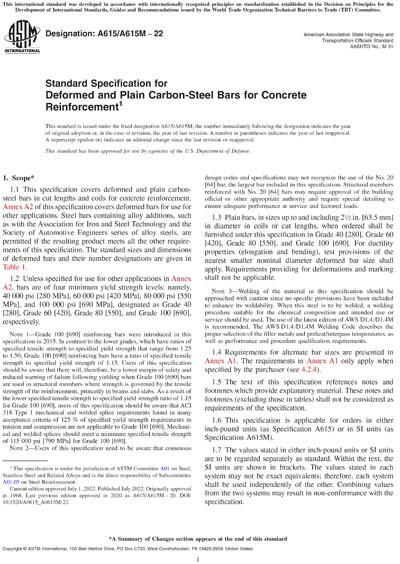Most recent
ASTM A615/A615M-22
Standard Specification for Deformed and Plain Carbon-Steel Bars for Concrete Reinforcement
1.1This specification covers deformed and plain carbon-steel bars in cut lengths and coils for concrete reinforcement. Annex A2 of this specification covers deformed bars for use for other applications. Steel bars containing alloy additions, such as with the Association for Iron and Steel Technology and the Society of Automotive Engineers series of alloy steels, are permitted if the resulting product meets all the other requirements of this specification. The standard sizes and dimensions of deformed bars and their number designations are given in Table 1.
1.2Unless specified for use for other applications in Annex A2, bars are of four minimum yield strength levels: namely, 40 000 psi [280 MPa], 60 000 psi [420 MPa], 80 000 psi [550 MPa], and 100 000 psi [690 MPa], designated as Grade 40 [280], Grade 60 [420], Grade 80 [550], and Grade 100 [690], respectively.
Note 1:Grade 100 [690] reinforcing bars were introduced in this specification in 2015. In contrast to the lower grades, which have ratios of specified tensile strength to specified yield strength that range from 1.25 to 1.50, Grade 100 [690] reinforcing bars have a ratio of specified tensile strength to specified yield strength of 1.15. Users of this specification should be aware that there will, therefore, be a lower margin of safety and reduced warning of failure following yielding when Grade 100 [690] bars are used in structural members where strength is governed by the tensile strength of the reinforcement, primarily in beams and slabs. As a result of the lower specified tensile strength to specified yield strength ratio of 1.15 for Grade 100 [690], users of this specification should be aware that ACI 318 Type 1 mechanical and welded splice requirements found in many acceptance criteria of 125 % of specified yield strength requirements in tension and compression are not applicable to Grade 100 [690]. Mechanical and welded splices should meet a minimum specified tensile strength of 115 000 psi [790 MPa] for Grade 100 [690].
Note 2:Users of this specification need to be aware that consensus design codes and specifications may not recognize the use of the No. 20 [64] bar, the largest bar included in this specification. Structural members reinforced with No. 20 [64] bars may require approval of the building official or other appropriate authority and require special detailing to ensure adequate performance at service and factored loads.
1.3Plain bars, in sizes up to and including 21/2in. [63.5 mm] in diameter in coils or cut lengths, when ordered shall be furnished under this specification in Grade 40 [280], Grade 60 [420], Grade 80 [550], and Grade 100 [690]. For ductility properties (elongation and bending), test provisions of the nearest smaller nominal diameter deformed bar size shall apply. Requirements providing for deformations and marking shall not be applicable.
Note 3:Welding of the material in this specification should be approached with caution since no specific provisions have been included to enhance its weldability. When this steel is to be welded, a welding procedure suitable for the chemical composition and intended use or service should be used. The use of the latest edition of AWS D1.4/D1.4M is recommended. The AWS D1.4/D1.4M Welding Code describes the proper selection of the filler metals and preheat/interpass temperatures, as well as performance and procedure qualification requirements.
1.4Requirements for alternate bar sizes are presented in Annex A1. The requirements in Annex A1 only apply when specified by the purchaser (see 4.2.4).
1.5The text of this specification references notes and footnotes which provide explanatory material. These notes and footnotes (excluding those in tables) shall not be considered as requirements of the specification.
1.6This specification is applicable for orders in either inch-pound units (as Specification A615) or in SI units (as Specification A615M).
1.7The values stated in either inch-pound units or SI units are to be regarded separately as standard. Within the text, the SI units are shown in brackets. The values stated in each system may not be exact equivalents; therefore, each system shall be used independently of the other. Combining values from the two systems may result in non-conformance with the specification.
1.8This standard does not purport to address all of the safety concerns, if any, associated with its use. It is the responsibility of the user of this standard to establish appropriate safety, health, and environmental practices and determine the applicability of regulatory limitations prior to use.
1.9This international standard was developed in accordance with internationally recognized principles on standardization established in the Decision on Principles for the Development of International Standards, Guides and Recommendations issued by the World Trade Organization Technical Barriers to Trade (TBT) Committee.
Content Provider
ASTM International [astm]






